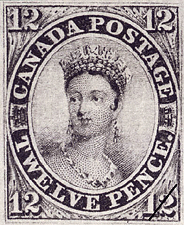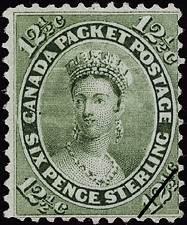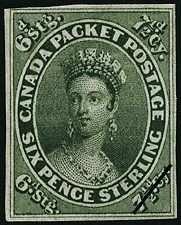Queen Victoria - 6 pence 1857 - Canadian stamp
Specifications
- Quantity: 100 080
- Issue date: June 2, 1857
- Printer: Rawdon, Wright, Hatch & Edson
- Paper: Wove paper
- Scott: #9
Queen Victoria - 6 pence 1857 prices and values
The value of a Queen Victoria - 6 pence 1857 stamp depends on several factors such as quality and wear, supply and demand, rarity, finish and more. Values in the section are based on the market, trends, auctions and recognized books, publications and catalogs. This section also includes information on errors and varieties and characteristics.

- Used
- Mint
- With gum
| VG | F | VF | Cover | |
|---|---|---|---|---|
| Queen Victoria - 6 pence 1857 | $400 | $1,200 | $2,400 | $3,600 |
| VG | F | VF | |
|---|---|---|---|
| Queen Victoria - 6 pence 1857 | $1,400 | $3,300 | $6,600 |
| VG | F | VF | |
|---|---|---|---|
| Queen Victoria - 6 pence 1857 | $2,800 | $6,600 | $13,200 |
Description
In 1854, reduced postal rates between Canada and the United Kingdom created a demand for 2 new denominations in postage stamps; 10-pence and 7½-pence. The Postmaster General's Report of March 31, 1854, announced in part the reduction of postal rates affecting the overseas mail to the United Kingdom. The mail of ½ ounce for each letter sent by packet ships from Halifax was charged at the reduced rate of 6-pence sterling equal to 7½-pence in currency. The rate was also reduced from 1-shilling and 2-pence sterling to 8-pence sterling on mail sent overseas by way of the United States. When W.H. Griffin wrote to the security printers he sketched a suggested design of the 10-penny stamps: "It would promote the public convenience to procure postage stamps of the value of 10-pence and 7½-pence to correspond with the packet letter charges." While these reductions were made in sterling the people in the Province of Canada were being drastically restricted by the confusion of money with its varying degrees of valuation. The Province of that time did not have a currency of its own. Sterling was of higher value than the monetary exchange commonly referred to as currency. For that reason, the new stamps in 10-pence has an additional inscription of 8-pence stg (sterling). The 7½-pence stamps were inscribed "Six Pence Sterling" in the oval frame of Queen Victoria's portrait.
This portrait of Queen Victoria was reproduced from a contemporary engraving of a full-length painting by Alfred Edward Chalon. Although this work of art portrays the young Queen in her robes of state, merely the head appears in various British colonial postage stamp designs. On the occasion of Queen Victoria's first visit to the House of Lords, she commissioned Mr. Chalon to paint this portrait as a gift to her mother, the Duchess of Kent. The memorable event was the prorogation of Parliament on July 17, 1837, the year of the Queen's accession to the throne.
Creators
Based on a painting by Alfred Edward Chalon
Portrait engraved by Alfred Jones
Original art
Alfred Edward Chalon, "Queen Victoria", 1837
Similar stamp(s)
| Scott | ||
|---|---|---|
 |
Queen Victoria - 12 pence 1851 The first postage stamp issue of the Province of Canada featured the beaver on the 3-pence, H.R.H. Albert, husband of the queen, on the 6-pence denomi... | #3 |
 |
Similar to the 7½-pence stamp of 1857. The denomination, "Six pence Sterling" remained on this stamp because it was issued to pay for pack... | #18 |
Right now on Ebay (Ad)
Stampsandcanada.com is supported by its audience. When you buy through links on our site, we may earn a commission.
View more »Note
The values on this page are in Canadian dollars (CAD).

